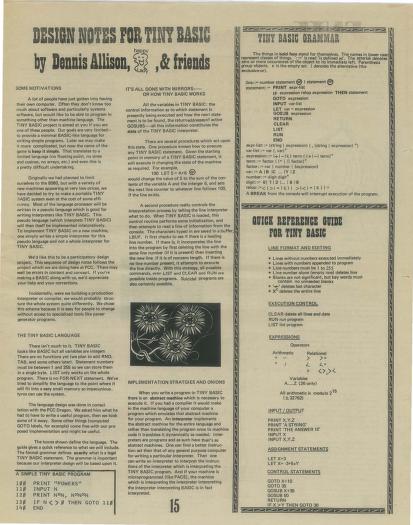LB geocities, I miss when people would just put up a page of stuff they like, esp if it's spinning skulls and lightning.
Me, too, "Tina".
#geocities #retrocomputing


@weirdunits one billion DIMMs... 👀
Still cannot figure out how to use the pre-processor so I can use .def or #define to label the registers something other than, eg., R17.
Other than that I have set up a simple tool chain and makefile environment where I am able to successfully assemble and then upload code to the Arduino.
I suppose the next step will be to look at the People's Computer Company Tiny BASIC, ZX80 BASIC, and a few others to get some inspiration for the overall design of the language.
IIRC, it goes:
Lexer
Parser
Interpreter
I kinda have this weird intellectual history where I didn't learn C, learned assembly for the 6502, and then learned common lisp :S
I should really do a nice devlog on how to set up a nice working environment for assembly programming on the Arduino platform.
Much of the information and tutorials are all windows-based, and people do not follow proper netiquette by posting solutions to errors in their forum posts.
Also kinda excited to try programming an AVR micro-controller just by itself, such as a single ATmega328.
The C64 was doing survival horror before Pyramid Head's bollocks descended.
This here is Frightmare, by Cascade. This shit was Nintendo Hard, and had atmosphere oozing out of it.
Here's what my bullet-point notes look like for each lesson. Basically just sketching out what to cover. If I get into scripting each episode I'll get lost in the weeds again and never put out anything.
Starting a big deep dive into AVR assembly.
I still cannot make my Arduino Mega's onboard LED blink, but I feel that will not be a problem for long.
so today i learned there's a youtube video of someone reading my "i use alpine actually" shitpost.
uploaded five years ago.
with over a hundred thousand views.
i am having a moment
A special thank you to all my Patreon supporters. You keep me going in ways that have little to do with the amount of your support -- that you care enough to support at all is immense to me.
Time to learn assembly for the AVR?
@neauoire , to answer the question that you posed to me on IRC, this is how I'm gonna write my own BASIC!
The idea will be to save as much memory for program listings as possible.
As someone else mentioned earlier, the ZX81 is a good model of microcomputer from which to take inspiration: I will look at the list of BASIC statements it implements and mirror that design!
See also:
https://github.com/trevorjay/atinybasic
“Headless, the interpreter only takes up 348 bytes of RAM, leaving the rest for BASIC programs themselves.”
Waiting on these parts before doing anything else.
The purpose of the TTGO VGA32 single board computer is to obtain the graphics functions of fabGL that are enabled on the board.
This will give the project some ability to assess whether word processing can be developed for the project using some graphics mode.
The purpose of the Pico VGA terminal is to give the project some ability to "put a head" on each of these micro-controller boards that the project has on hand:
- Arduino Pro Micro
- Arduino Mega
- Raspberry pi pico

 🇨🇦
🇨🇦

